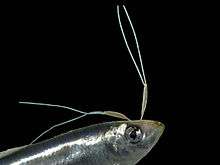Lernaeenicus sprattae
Lernaeenicus sprattae is a species of copepod in the family Pennellidae. It is a parasite of the European sprat (Sprattus sprattus) and certain other fish and is sometimes known as the sprat eye-maggot.[3]
| Lernaeenicus sprattae | |
|---|---|
 | |
| Lernaeenicus sprattae on host European sprat | |
| Scientific classification | |
| Kingdom: | |
| Phylum: | |
| Subphylum: | |
| Class: | |
| Subclass: | |
| Order: | |
| Family: | |
| Genus: | Lernaeenicus |
| Species: | L. sprattae |
| Binomial name | |
| Lernaeenicus sprattae | |
| Synonyms[1] | |
| |
Distribution
Lernaeenicus sprattae is a parasite of the European sprat (Sprattus sprattus) in northwestern Europe, of the European pilchard (Sardina pilchardus) in southwestern Europe, the Mediterranean Sea and the Black Sea, and of the halfbeak (Hemiramphus far) in the Indo-Pacific region.
Ecology
This copepod has a large number of developmental-stages, some free-living and some parasitic. Two naupliar stages and the first copepodid stage are free-living and are followed by a second copepodid stage where the larva grasps a host fish. This is followed by four chalimus stages (nymphal stages) where the larvae are parasitic on the host. During the next stage, the adults are free-living and mate, the male dying soon after copulation. The female moults once more before reattaching to a sprat, either on its external surface or by invading the eye; while in the eye, the female transforms into a mature adult with two attached strings of eggs.[3] The earliest naupliar stages take place before the eggs hatch and are released from the strings. Altogether there are fourteen developmental stages. The life cycle is very similar to that of Lernaeenicus branchialis,[3] a parasite of the European flounder (Pleuronectes flesus), the common sole (Solea solea) and the lumpsucker (Cyclopterus lumpusbut),[4] but the cycle is slower, with each of the developmental stages taking longer.[3]
Damage
This copepod can cause lesions to the skin of the fish and damage to the underlying tissues. In the sprat, it burrows into the eye, causing the lens to become opaque, the retina to distort and buckle, and bleeding to occur. The fish's vision is reduced and it may be blinded in that eye. In the halfbeak, it usually attaches to the flanks, burying its head in the nearest accessible organ, usually the kidney, but sometimes the gonad. Here a cyst forms around the head, claws hold the parasite firmly in place and blood is sucked. Heavy infestations can weaken and even kill the host fish.
References
- Boxshall, Geoff (2018). "Lernaeenicus sprattae (Sowerby, 1806)". WoRMS. World Register of Marine Species. Retrieved 8 August 2018.
- Sowerby, James (1806). The British miscellany, or, Coloured figures of new, rare, or little known animal subjects : many not before ascertained to be inhabitants of the British Isles : and chiefly in the possession of the author, James Sowerby. London: R. Taylor & Co. doi:10.5962/bhl.title.41623.
- Schram, Thomas A. (1979). "The life history of the eye-maggot of the sprat, Lernaeenicus sprattae (Sowerby) (Copepoda, Lernaeoceridae)". Sarsia. 64 (4): 279–316. doi:10.1080/00364827.1979.10411388.
- Sproston, Nora G. (1942). "The developmental stages of Lernaeocera branchialis (Linn.)" (PDF). Journal of the Marine Biological Association of the UK. 25 (3): 441–466. doi:10.1017/S0025315400055090.
External links

